ANCESTRY RESEARCH:
To access the Request for Baptismal/Marriage/Burial/Genealogy
Records for Ancestry Research, please CLICK HERE.
OUR PARISH HISTORY:
Humble Beginnings
A little more than one hundred years ago, a vast wave of immigrants from southern Europe—almost 25 million men, women, and children—swept onto the shores of the United States, lured by the promise of a better life and the chance to escape from the difficult conditions of their homelands. Of these, the largest group was from the impoverished southern and central regions of Italy.
From the region of Abruzzo, a number of immigrants found their way to the villages of Strafford, Devon, and Wayne, and took up positions as builders, stonemasons, gardeners, and chauffeurs to the wealthy Philadelphians who had begun to build their summer homes to the west of the city along the Main Line of the Pennsylvania Railroad.
These overwhelmingly Catholic immigrants sought places of worship in the area and tried to find them in the already established local “Irish” churches; but, as Italians, they were discouraged by a sometimes unfriendly reception, unfamiliar worship practices, and—most importantly—the lack of priests who spoke their language.
One devout young Italian immigrant woman was moved to action. Rosaria Cimini DiLorenzo had 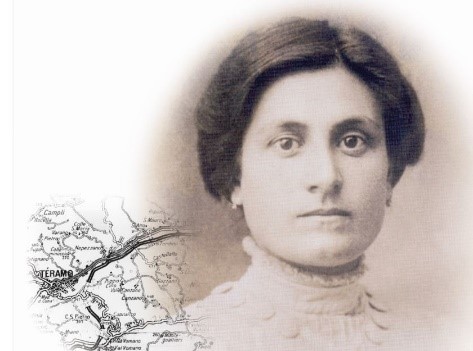 emigrated from Teramo (Abruzzo), Italy, in 1903 as a young bride of 18 years in age. After moving with her husband to the Italian settlement in Strafford, she had become deeply concerned for the spiritual welfare of this immigrant community. In 1907, now 22 years old and the mother of two young girls, she wrote a letter to Pope Pius X, explaining the immigrants’ plight and imploring him to send an Italian priest to minister to the growing Main Line Italian community.
emigrated from Teramo (Abruzzo), Italy, in 1903 as a young bride of 18 years in age. After moving with her husband to the Italian settlement in Strafford, she had become deeply concerned for the spiritual welfare of this immigrant community. In 1907, now 22 years old and the mother of two young girls, she wrote a letter to Pope Pius X, explaining the immigrants’ plight and imploring him to send an Italian priest to minister to the growing Main Line Italian community.
Father Landolfi and the Founding of the Parish, 1908
At this time, the Catholic Church in the United States was preoccupied with what became known as the “Italian Problem” (so named mainly because of the vast number of Italians immigrants, though other nationalities were also included): what to do about the masses of very poor, mostly illiterate, largely Catholic immigrants that were overwhelming the existing Catholic parishes. Eventually, the favored solution became the establishment of “national” parishes, with a priest who could minister to the people in their own language.
It was in this context that Rosaria Cimini DiLorenzo’s courageous effort moved Archbishop Ryan to appoint Father Aemilius Landolfi in early 1908 to found a parish for Main Line Italian immigrants.
Father Landolfi arrived in Strafford in January 1908 and immediately set to work. He chose for the new parish the name of the Cimini family’s old parish church in Teramo: Santa Maria Assunta, Our Lady of the Assumption.
While searching for a home for the parish, he learned of Strafford Hall, a small wood-frame building on Old Eagle School Road that had lately been the home of the Strafford Union Sunday School of St. David’s Church, Radnor. This aging building had recently been sold and was due to be torn down.
On February 10, 1908, Father Landolfi requested permission from the archbishop to borrow $1500 to acquire it for the parish. A few weeks later, he purchased the little building and also secured from the landowner a small corner of land on which it could be moved.
In late March 1908, the structure was hoisted on railway ties and moved down Old Eagle School Road to its new location (now the site of the present parish hall). There, on June 7, 1908, it was blessed as the new Italian Church of Our Lady of the Assumption.
Created exclusively for Italian immigrants to the Main Line area, Our Lady of the Assumption was the eighth Italian national parish in the Archdiocese of Philadelphia. It is perhaps the only parish to claim a laywoman as its founder.
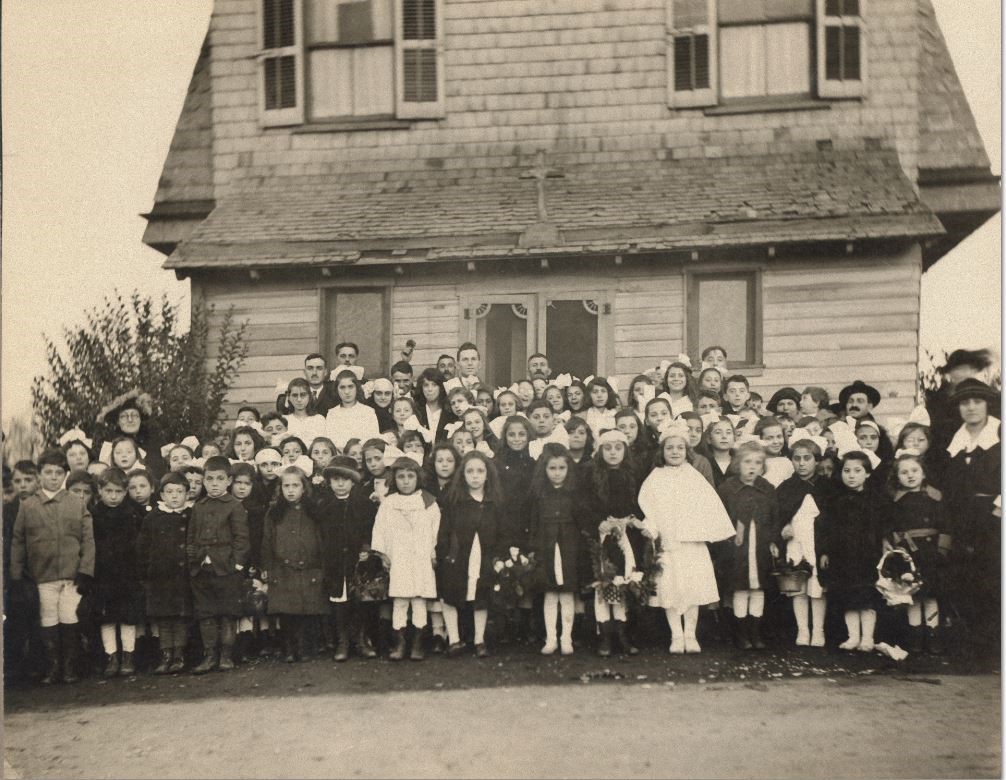
Father Louis Fiorillo and Father Carmine Cillo, 1909-1911
For the first three years, the parish’s survival seemed tenuous: Father Landolfi remained only a few months, followed by another short-lived pastor, Father Louis Fiorillo, who was in fact absent for several months of his pastorate for personal reasons. He was replaced during those months by Father Carmine Cillo. In addition, almost no money was being collected for parish expenses. Despite this instability, the community maintained a vigorous hope for its fledgling parish and needed only a determined and devoted pastor who, like them, was not afraid of sacrifice, nor discouraged by disappointment. Finally in August 1911, the awaited pastor arrived in the person of an older priest from Messina, Sicily—Father Antonio Scialabba.
Father Antonio Scialabba, 1911-1947
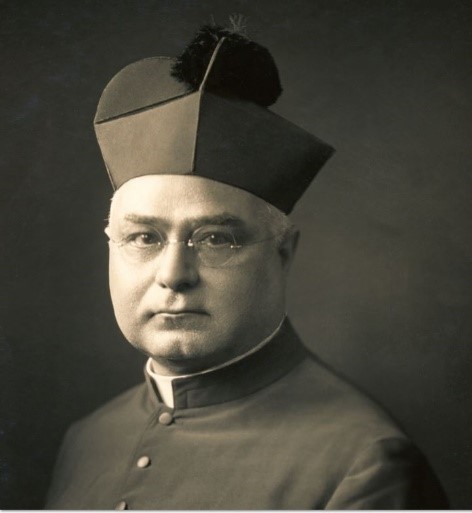 At this time, the parish consisted of about 100 families—of fervent faith but very modest means. Sunday plate collections did not amount to more than $10 per week. Yet Father Scialabba saw immediately that the aging wooden chapel would soon need to be replaced, and that the future of the parish depended on its having a strong and permanent home. Moreover, the parish did not yet officially own the land on which sat the chapel (the chapel’s location on the property had only been a temporary arrangement).
At this time, the parish consisted of about 100 families—of fervent faith but very modest means. Sunday plate collections did not amount to more than $10 per week. Yet Father Scialabba saw immediately that the aging wooden chapel would soon need to be replaced, and that the future of the parish depended on its having a strong and permanent home. Moreover, the parish did not yet officially own the land on which sat the chapel (the chapel’s location on the property had only been a temporary arrangement).
With the parishioners’ hearty support and their promises of free labor, Father Scialabba set his sights on building a new stone church, and from the beginning worked tirelessly toward that goal, despite many discouragements.
United in their desire for this new church—and in their trust in Providence—Father Scialabba and the Italian community forged a relationship of love, devotion, hard work, and sacrifice which culminated in late 1921 in the purchase of one-and-a-half acres of land, the opening of the cemetery, and the laying of the cornerstone for a new stone church.
The Stone Church
Less than a year later, on the Feast of the Assumption of 1922, the joyful Italian community participated in the blessing of the new church, built entirely by the hands of parishioners. A two-story rectory was built later the same year.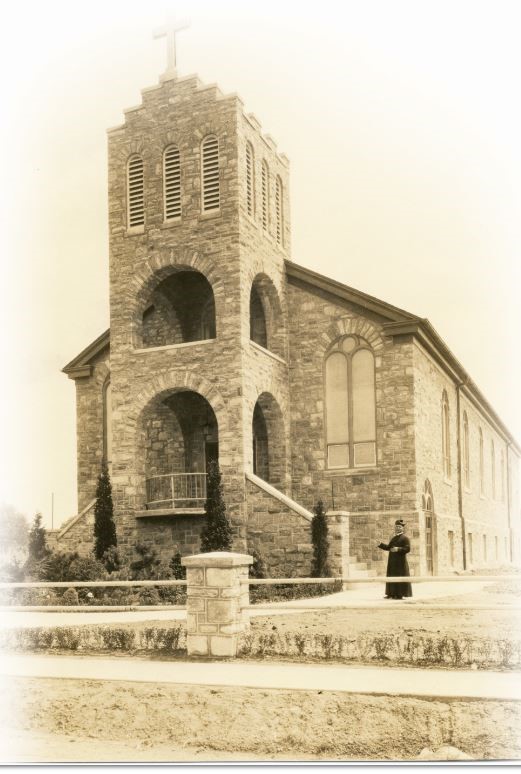
Both church and rectory were constructed of limestone taken from a quarry in Howellville. The stone was hauled to Strafford by horse and cart, where it was chiseled by hand into blocks and set by the parish’s expert stonemasons.
The church is built on the basilica plan, with an east-west axis, and its architectural style is Romanesque Revival, characterized by the semicircular arch.
The total cost of the construction soared to $70,000, the major part of which remained as parish debt for the next 25 years.
Special mention must be made of the generous contributions of non-Italian residents of the area, in particular the pastors—Father Joseph O’Keefe and Monsignor Charles Kavanagh—of St. Katharine of Siena Church in Wayne, and many of that church’s members.
Father Scialabba remained as the devoted and beloved pastor for 36 years, guiding the parish through the Depression and WWII years, until his death in December 1947. He was accorded the highest honor by the parishioners and was buried directly in front of the church he built and loved.
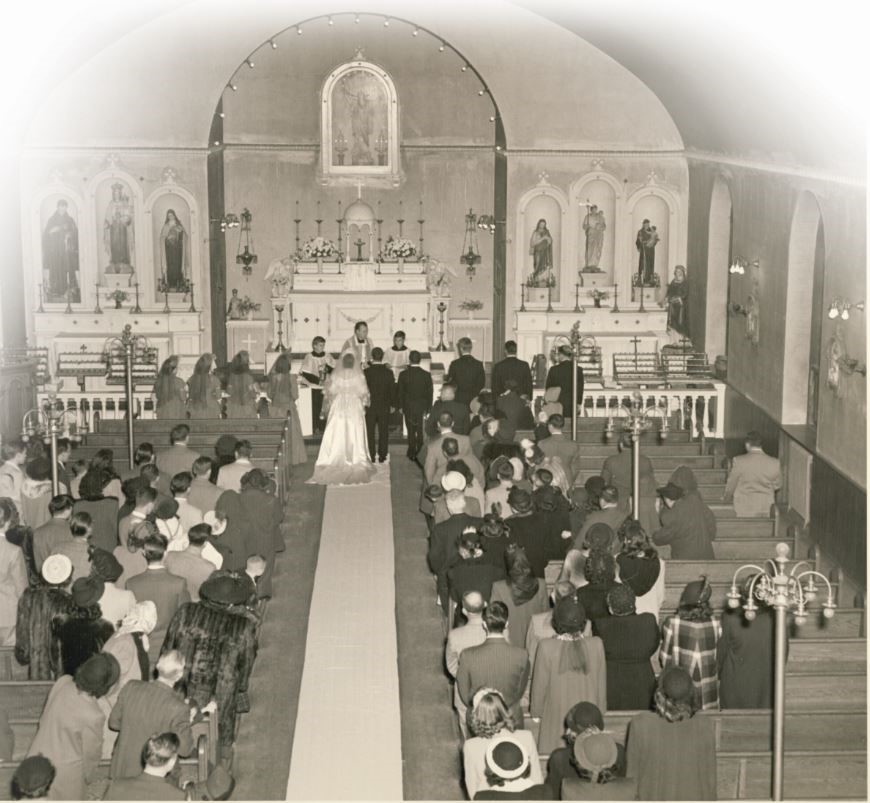
The Annual Parish Feast
Each year in August the parish, in cooperation with the local Italian societies, celebrated the Feast of the Assumption with a festa in honor of the parish’s patroness, continuing a custom brought over from their homeland. The festa included a triduum (three days of prayerful preparation at the church), followed by a Solemn High Mass on the feast day itself, August 15. After the services, there were featured an Italian band, games, plenty of Italian food made by women of the parish, and a spectacular display of fireworks. For many years, this event was the highlight of the year on the Main Line, and people came from miles around to participate. News articles from the 1920s cite attendances of up to 10,000 people.
Father Francis Rauseo, 1947-1952
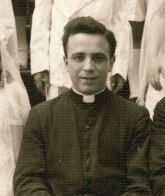 By the late 1940s, a new generation had grown up in the parish, and the old-country habits of the founding members were giving way to the more modern ways of their American-born children. The parish population was no longer Italian, but Italian-American. In addition, the prosperity of the post-war years meant that the parish was now on a solid financial footing.
By the late 1940s, a new generation had grown up in the parish, and the old-country habits of the founding members were giving way to the more modern ways of their American-born children. The parish population was no longer Italian, but Italian-American. In addition, the prosperity of the post-war years meant that the parish was now on a solid financial footing.
In December 1947, the new pastor, Father Francis Rauseo (born in Philadelphia of Italian immigrant parents), brought a youthful energy to the much-needed revitalization of the parish. Wasting no time, he repaid the parish debt, purchased the property across Old Eagle School Road (which became the overflow parking lot), started the Sodality and the Holy Name societies, completed the as yet unfinished rectory, and oversaw the total renovation of the interior of the church—once again by the hands of parishioners. The paintings on the ceiling of the church date from this time, the work of a Philadelphia-based Italian painter, Mario Sgambati. Lastly, Father Rauseo can be credited with beginning plans for a parish school.
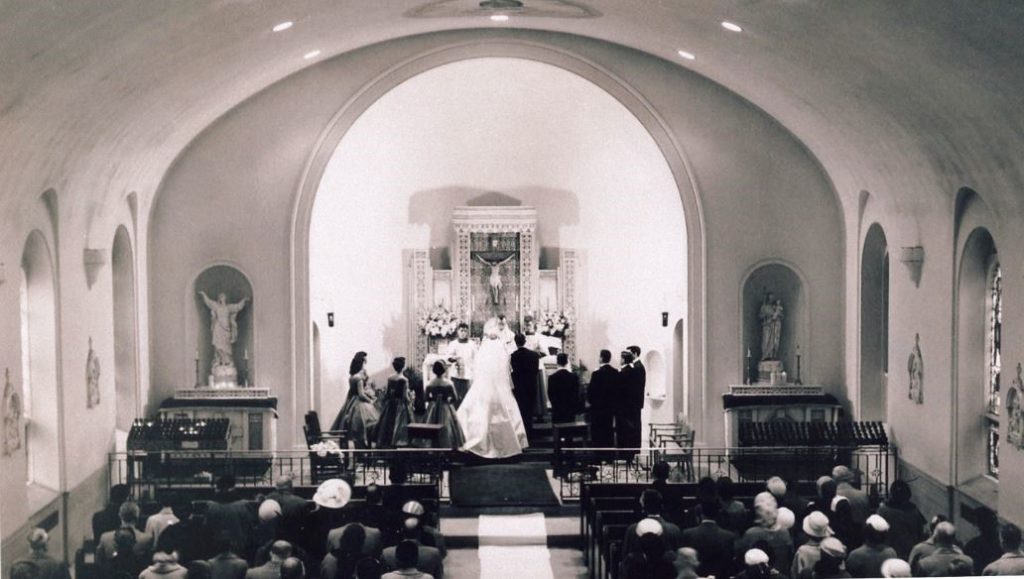
Father Crispino DeLuca, 1952-1982
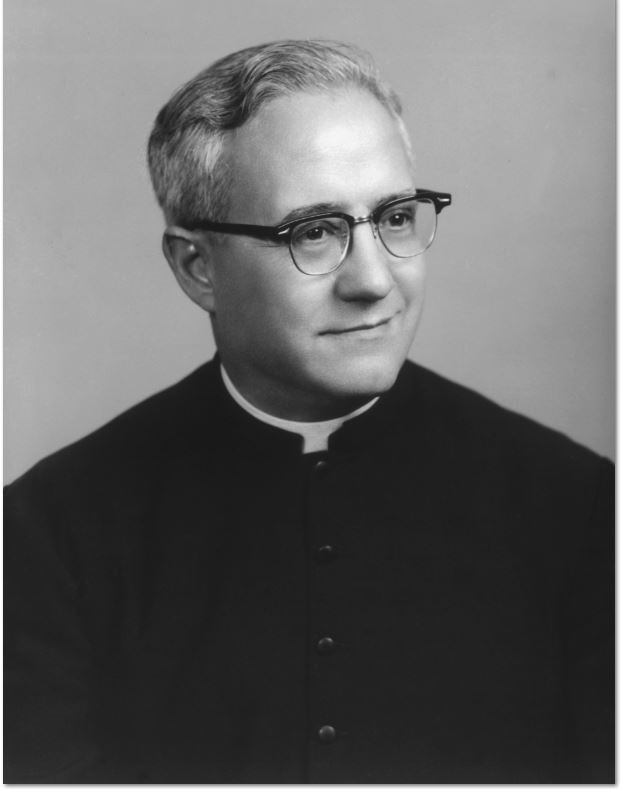 After five years of intense activity, Father Rauseo requested a transfer for health reasons and was replaced in August 1952 by Father Crispino DeLuca, who emigrated from Italy in 1939. Father DeLuca remained as pastor until his death 30 years later. During his pastorate, the parish acquired the property in Radnor Township, Delaware County (the rest of church property lies in Tredyffrin Township, Chester County), and saw the construction of the parish elementary school in 1955 and the convent for the teaching sisters, the Grey Nuns of the Sacred Heart, in 1960.
After five years of intense activity, Father Rauseo requested a transfer for health reasons and was replaced in August 1952 by Father Crispino DeLuca, who emigrated from Italy in 1939. Father DeLuca remained as pastor until his death 30 years later. During his pastorate, the parish acquired the property in Radnor Township, Delaware County (the rest of church property lies in Tredyffrin Township, Chester County), and saw the construction of the parish elementary school in 1955 and the convent for the teaching sisters, the Grey Nuns of the Sacred Heart, in 1960.
The school opened in September 1955 with Sister Mary Dorothy as the first principal. That year there were 102 students in six grades, who would be taught by four sisters, one of whom was the principal. The dedication of the school took place in April 1956. By 1962, enrollment reached its peak of 337 pupils in eight grades.
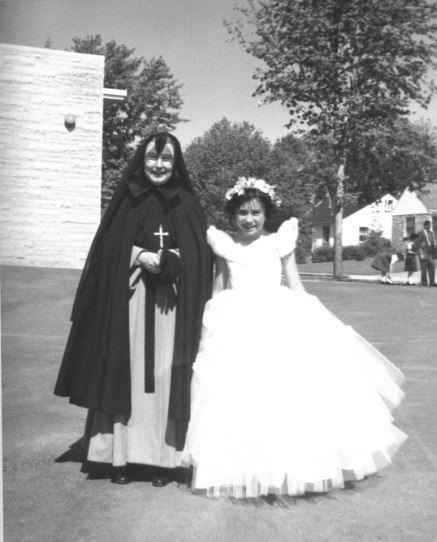
In order to help fund the expenses of building a school, Father DeLuca requested, and was granted, a new hybrid status for Our Lady of the Assumption. From an Italian “national” parish, it now became a “national-territorial” parish, permitting non-Italians residing close to the church to become members, if they so chose.
With the opening of the school, parish spirit and cooperation reached new heights, and a dedicated group of parents happily spent countless hours to raise money, through well-attended social functions and fundraisers, to benefit the school.
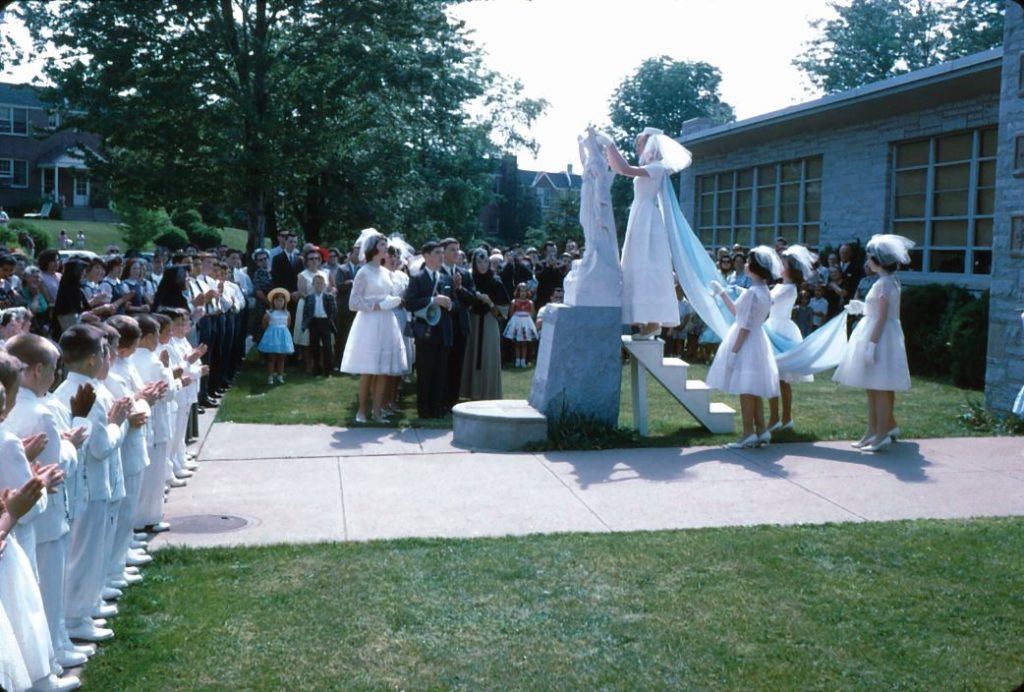
School enrollment was strong, and now additional space was badly needed in the school. In 1972, after a vigorous campaign, a two-story multipurpose wing was added to the school, funded for the most part by parishioner contributions. This new parish hall provided much-needed space for school and parish events.
Sadly, a gradual but continuous drop in enrollment over the next few years led to the devastating decision to close the school in 1976. This was a great blow to the parish, which suffered a serious decline in contrast to the past years of tremendous growth.
Father Daniel Pirolli, 1982-1987
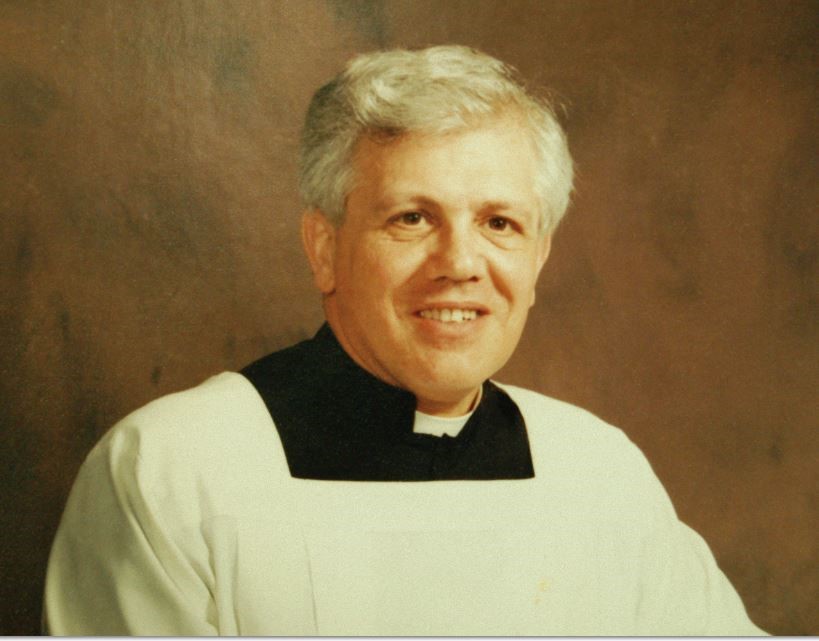 After the death of Father DeLuca in 1982, Cardinal Krol appointed a first-time pastor, Father Daniel Pirolli, who had been a teacher for many years and who was then serving as chaplain to the IHM sisters at Camilla Hall.
After the death of Father DeLuca in 1982, Cardinal Krol appointed a first-time pastor, Father Daniel Pirolli, who had been a teacher for many years and who was then serving as chaplain to the IHM sisters at Camilla Hall.
After the somewhat distant, authoritarian style of the previous pastor, Father Pirolli astonished the congregation with his opening words, borrowed from St. Teresa of Avila, at his first Mass, “I come only to serve.”
Father Pirolli had wanted nothing more than to be a pastor; and now his gratitude for this gift of 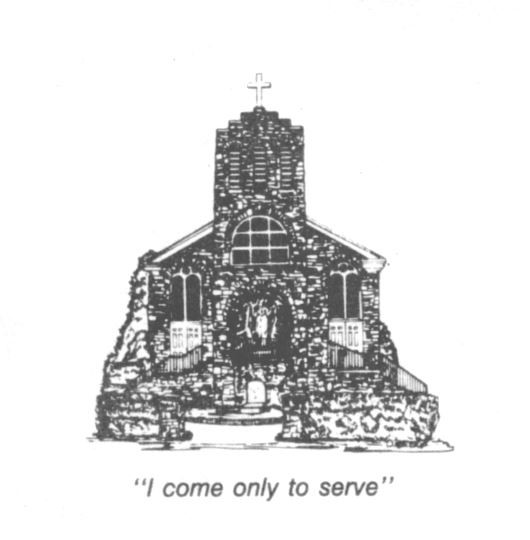 the pastorate of Our Lady of the Assumption was evident in the joy he put into his pastoral duties. By his gentle, encouraging ways, and his infectious enthusiasm, he soon had parishioners rolling up their sleeves and happily taking part in parish renewal, both spiritually and materially.
the pastorate of Our Lady of the Assumption was evident in the joy he put into his pastoral duties. By his gentle, encouraging ways, and his infectious enthusiasm, he soon had parishioners rolling up their sleeves and happily taking part in parish renewal, both spiritually and materially.
As it had been for Father DeLuca, the parish’s “optional” boundaries were a source of frustration for Father Pirolli. However, his request for full territorial status led to an archdiocesan review of surrounding parishes’ memberships—culminating in the unwelcome ruling that Our Lady of the Assumption revert to its original (pre-1955) status of an Italian “national” parish, restricted to persons of Italian descent. This restriction would hold until the early 2000s.
During his pastorate, Father Pirolli reopened the parish school as a preschool and kindergarten—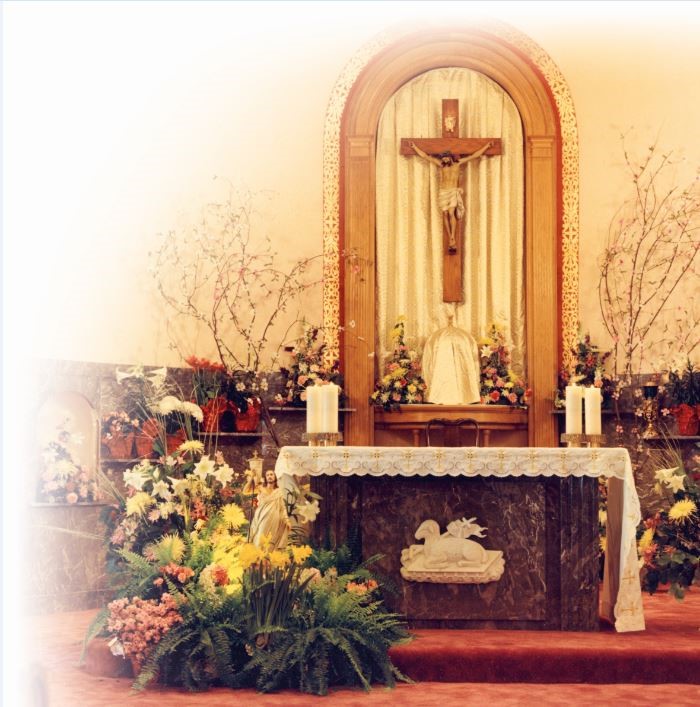 still in operation today—and made restorations to the interior of the church. He also began renovations and improvements to the rectory, from its somewhat austere condition to a comfortable home for the priests.
still in operation today—and made restorations to the interior of the church. He also began renovations and improvements to the rectory, from its somewhat austere condition to a comfortable home for the priests.
But his greatest legacy is the renewal of hope and pride in their parish that he inspired in the parishioners by his own loving, compassionate, and grateful nature, and his example of humble and joyful service. Parishioners who knew him speak of Father Pirolli with great love and admiration for his saintly ways.
To general surprise, he had succeeded in turning a declining, demoralized parish into a flourishing one. His untimely death from cancer in July 1987 was deeply mourned by all. He was buried in the parish cemetery, the second pastor to be so honored.
Father Louis D’Addezio, 1987-1989
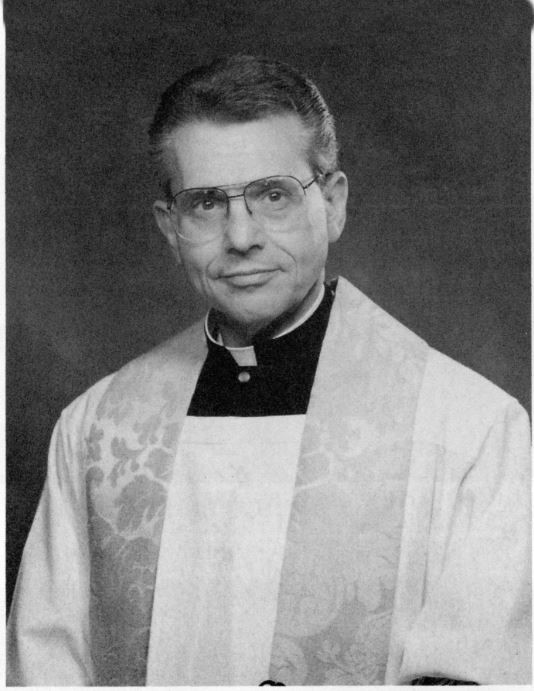 The next pastor, Father Louis D’Addezio, swept in like a strong wind in September 1987 from his previous post as principal of Cardinal Dougherty High School. A man of boundless energy, he soon had compiled a list of “a million things” to do at Our Lady of the Assumption.
The next pastor, Father Louis D’Addezio, swept in like a strong wind in September 1987 from his previous post as principal of Cardinal Dougherty High School. A man of boundless energy, he soon had compiled a list of “a million things” to do at Our Lady of the Assumption.
Father D’Addezio was overjoyed at his pastoral appointment to Our Lady of the Assumption, a parish already dear to his heart because of family connections. Like his classmate and friend, Father Pirolli, he launched himself wholeheartedly into his duties. His cheerful nature and brimming optimism were irresistible, and during his short pastorate the parish hummed with activity.
Gifted with an artist’s eye, Father D’Addezio contributed greatly to the beautification of the church. He created the piazza, the courtyard in which the parish displays its seasonal decorations. He built the sacristy, making it beautiful as well as functional. He completed the church and rectory renovations left unfinished by the death of Father Pirolli and restored the aging stained glass windows. He used his love of theater and sense of pageantry to stage a spectacular celebration in honor of the Feast of the Assumption.
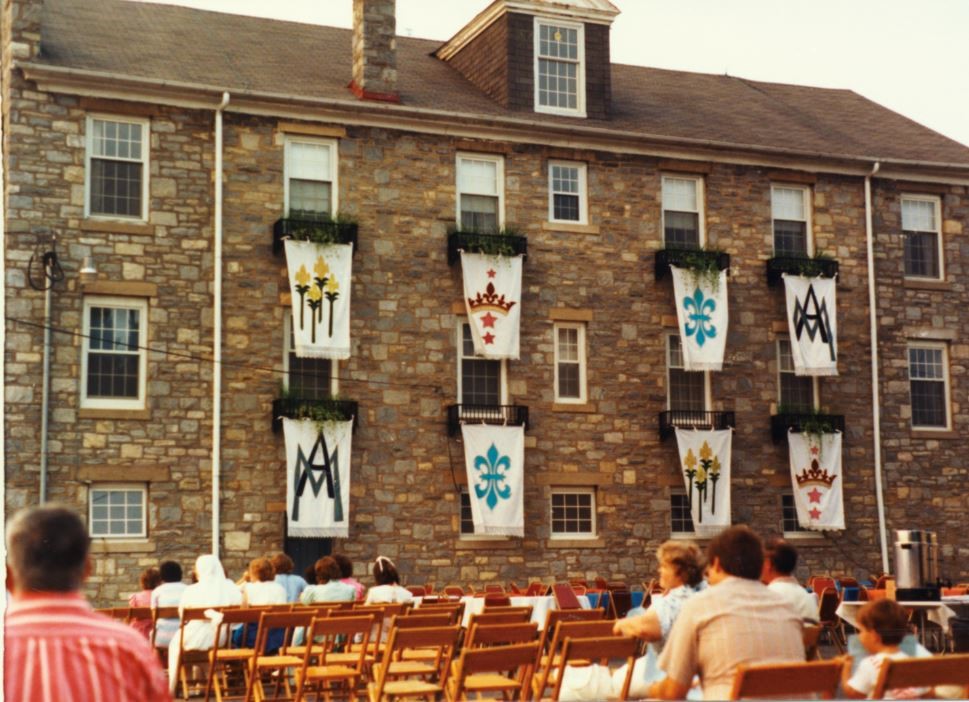 In other areas, he formed a board of directors for the parish preschool, a finance council, and a parish advisory board (pre-dating the Parish Pastoral Council).
In other areas, he formed a board of directors for the parish preschool, a finance council, and a parish advisory board (pre-dating the Parish Pastoral Council).
All this was accomplished in two short years, after which Father D’Addezio was called away, his considerable talents being required elsewhere. Our Lady of the Assumption welcomed its next pastor in June 1989, Father Eugene Carbo.
Father Eugene Carbo, 1989-2000
F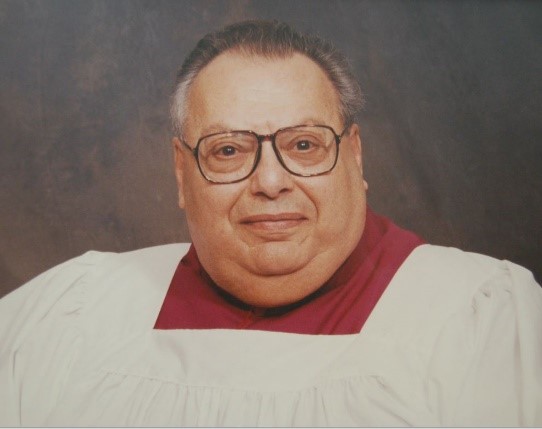 ather Carbo brought with him a kindness, a big-hearted warmth, and a joviality that endeared him immediately to the parishioners. A man of prayer, who loved the priesthood, he was also a great fan of the Italian food served up at the parish festa.
ather Carbo brought with him a kindness, a big-hearted warmth, and a joviality that endeared him immediately to the parishioners. A man of prayer, who loved the priesthood, he was also a great fan of the Italian food served up at the parish festa.
One of his first tasks was to reopen the issue of the parish’s status. As with Father Pirolli, the attempt did not meet with success, and Our Lady of the Assumption was forced to remain, throughout his pastorate, a parish restricted to people of Italian descent.
In 1993, following the directive of the archdiocesan Plan for Pastoral Renewal, Father Carbo formed the Parish Pastoral Council, which soon wrote up the first Parish Mission Statement and Pastoral Plan. He oversaw many improvements to church, school, and grounds, adding his own special touches. In 1993, he purchased the house adjacent to the church, making it available for use as an office for the vicar of Chester County. In 1999, the new Allen organ was acquired.
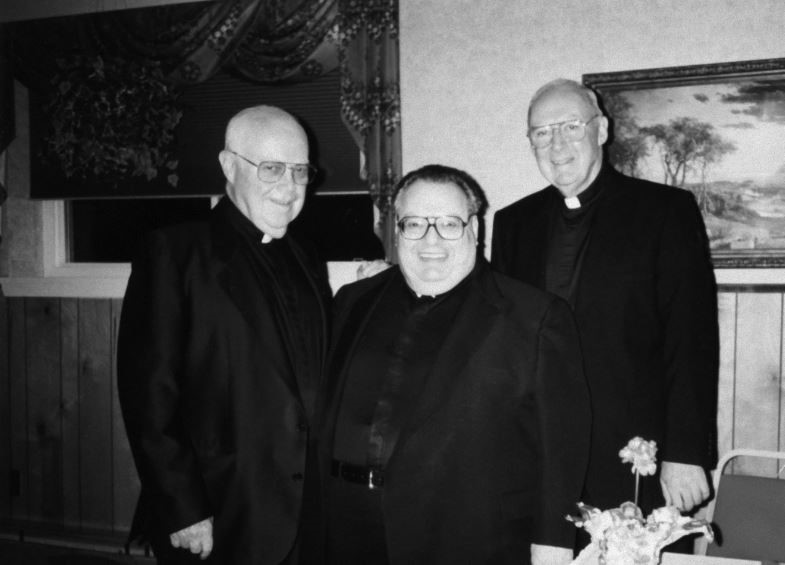 Under his pastorate, parish societies continued to flourish, especially the Sodality and the Legion of Mary, supported by Father Carbo’s deep devotion to the Blessed Mother. On March 14, 1998, Father Carbo was elevated to the rank of monsignor by Pope John Paul II.
Under his pastorate, parish societies continued to flourish, especially the Sodality and the Legion of Mary, supported by Father Carbo’s deep devotion to the Blessed Mother. On March 14, 1998, Father Carbo was elevated to the rank of monsignor by Pope John Paul II.
Always a victim of poor health, Father Carbo, with great regret, requested and was granted early retirement in 2000. He departed in August 2000 and was named pastor emeritus.
Father Joseph Vadino, 2000-2005
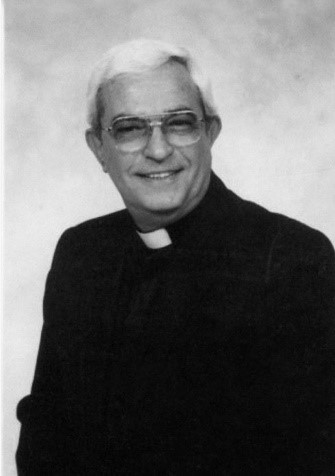 Father Joseph Vadino, the next pastor, arrived in August 2000, already familiar with the parish because of his earlier stay as priest-in-residence (1965-80). A deeply religious man, he took his priestly calling very seriously, and often spoke of his profound spiritual experiences.
Father Joseph Vadino, the next pastor, arrived in August 2000, already familiar with the parish because of his earlier stay as priest-in-residence (1965-80). A deeply religious man, he took his priestly calling very seriously, and often spoke of his profound spiritual experiences.
Father Vadino’s contributions to the growth of Our Lady of the Assumption were spiritual and intellectual, rather than material. Through sermons, writings, and the yearly Lenten lecture series that he instituted in 2001, he enjoined his congregation to be diligent in their Christian duties and to continually deepen their faith, especially through devotion to the Eucharist and study of Scriptures.
Throughout his pastorate, Father Vadino wrote and spoke extensively in defense of the Catholic 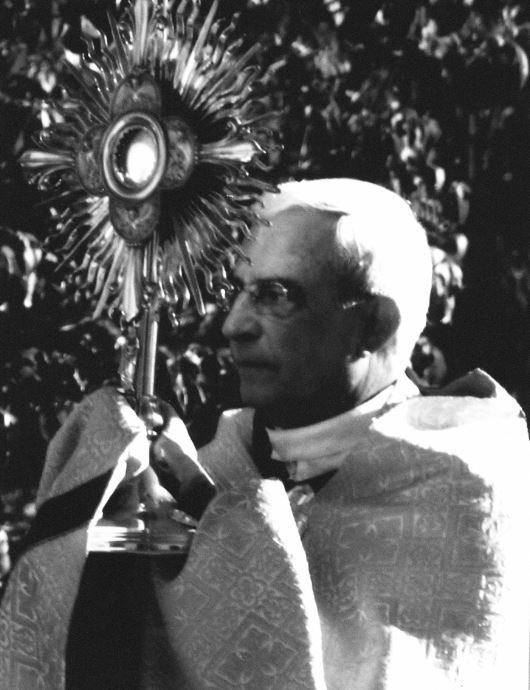 Church and its teachings. In addition to his contributions in the area of adult religious education, he was also greatly revered for the kindness and compassion he showed to those most in need of spiritual comfort and guidance.
Church and its teachings. In addition to his contributions in the area of adult religious education, he was also greatly revered for the kindness and compassion he showed to those most in need of spiritual comfort and guidance.
On June 8, 2005, came the sad news of the death of the previous pastor, Monsignor Carbo. Four days later, on June 12, after a church service which was part of the wake for Monsignor Carbo, Father Vadino was exiting the rectory when he collapsed on the steps. He was rushed to the hospital but succumbed to a massive heart attack a short time later.
The parish was plunged into grief with the death of two of its pastors in one week, and for some time many felt lost and confused. Then, by late summer 2005, the imminent arrival of the next pastor completely absorbed the parish’s attention.
Monsignor Daniel Thomas, 2005-2006
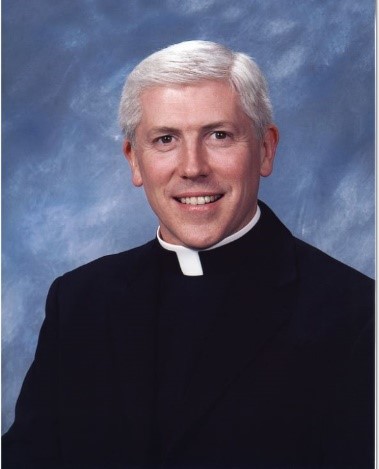 The news of the appointment of Monsignor Daniel E. Thomas—who would be the first non-Italian pastor in the parish’s history—caused quite a stir. It was known, however, that he had spent the last 18 years in Rome and spoke fluent Italian.
The news of the appointment of Monsignor Daniel E. Thomas—who would be the first non-Italian pastor in the parish’s history—caused quite a stir. It was known, however, that he had spent the last 18 years in Rome and spoke fluent Italian.
At his first Mass in late September 2005, his opening words (and his signature phrase) in Italian: “Sia lodato Gesù Cristo! Sempre sia lodato!” (“Praised be Jesus Christ, now and forever!”) generated an enthusiastic response from the congregation. After Mass, his warm words of greeting—in English and Italian—further endeared the new pastor to his parishioners.
To many, another source of surprise and wonder was his resemblance to a previous beloved pastor, Father Daniel Pirolli.
In subsequent weeks, Monsignor Thomas’s fervent belief in the parish’s potential to be great 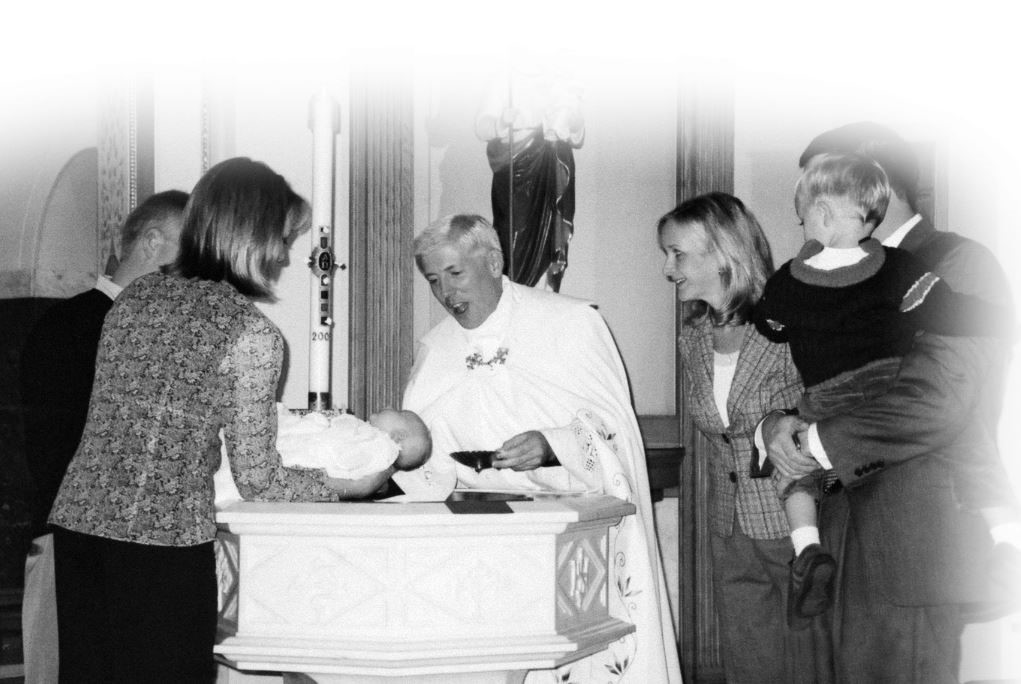 became the catalyst for a reinvigoration of parish spirit that had lately suffered a decline. Many parishioners responded to his calls for help, encouraged by his own very visible involvement at every level of parish activity: by his presence at every Mass during Holy Communion distribution, by his cheerful greetings after Masses, by his visits to the homebound parishioners, by his efforts to participate in meetings of every parish organization.
became the catalyst for a reinvigoration of parish spirit that had lately suffered a decline. Many parishioners responded to his calls for help, encouraged by his own very visible involvement at every level of parish activity: by his presence at every Mass during Holy Communion distribution, by his cheerful greetings after Masses, by his visits to the homebound parishioners, by his efforts to participate in meetings of every parish organization.
In addition, Monsignor Thomas reinstituted the youth group, set up a parish website team, formed a property committee to evaluate needs and renovations, and added to plans for the parish’s centennial anniversary in 2008.
Besides the plans for the centennial observance, Monsignor Thomas also planned for several improvements to the church and rectory. All these plans were cut short, however, when within eight months of his arrival, he was unexpectedly called away from his pastoral work: in June 2006, Cardinal Rigali informed him that Pope Benedict XVI had appointed him auxiliary bishop of Philadelphia.
The parish was plunged into confusion again, and wildly conflicting emotions alternated. Parishioners were heartbroken to lose their beloved pastor so soon, yet so proud of his elevation. 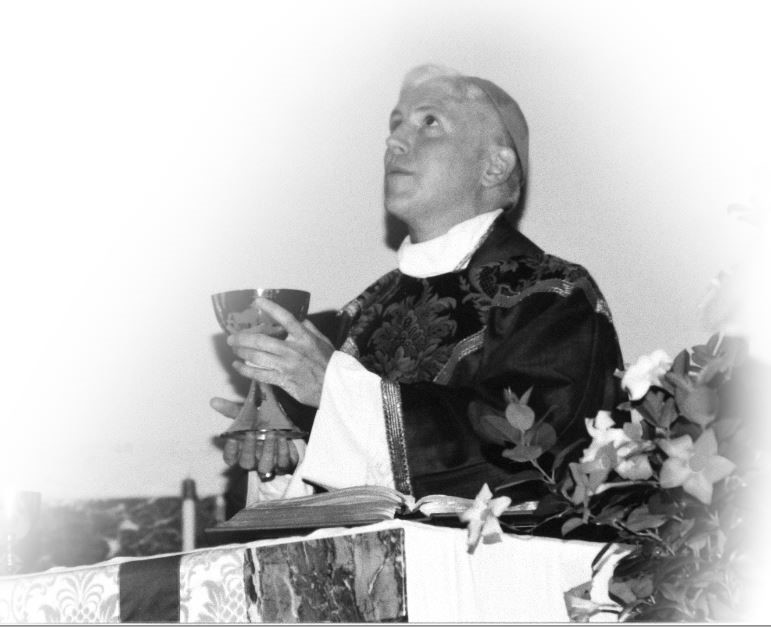 Father Daniel Hoy, long-time parish priest-in-residence, captured the essence of the parish’s pride with his memorable phrase: “It takes nine months to make a baby; it took only eight months for Our Lady of the Assumption to make a bishop!”
Father Daniel Hoy, long-time parish priest-in-residence, captured the essence of the parish’s pride with his memorable phrase: “It takes nine months to make a baby; it took only eight months for Our Lady of the Assumption to make a bishop!”
The Episcopal Ordination of Bishop Daniel E. Thomas took place on July 26, 2006, at the Cathedral Basilica of Ss. Peter and Paul in Philadelphia. When the overflowing congregation erupted in approval at the conclusion of the service, the most enthusiastic applause of all came from a proud, tearful group of parishioners from Our Lady of the Assumption Parish.
Monsignor Joseph Marino, 2006-2013
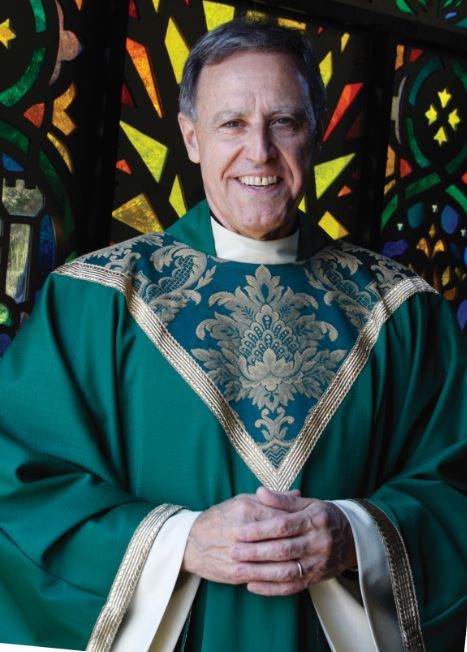 Monsignor Joseph T. Marino was installed as pastor of Our Lady of the Assumption on August 19, 2006, and, a few months later, was appointed vicar of Chester County, after the retirement of Monsignor James McDonough. (Monsignor McDonough continued at OLA as a beloved priest-in-residence until his move to St. Joseph’s Villa in 2012.) Monsignor Marino’s assignment to these dual roles was a testament to the esteem in which his leadership abilities were held.
Monsignor Joseph T. Marino was installed as pastor of Our Lady of the Assumption on August 19, 2006, and, a few months later, was appointed vicar of Chester County, after the retirement of Monsignor James McDonough. (Monsignor McDonough continued at OLA as a beloved priest-in-residence until his move to St. Joseph’s Villa in 2012.) Monsignor Marino’s assignment to these dual roles was a testament to the esteem in which his leadership abilities were held.
Monsignor Marino brought to Our Lady of the Assumption his considerable skill as an administrator, as well as his past experience as first director of the Office of Pastoral Renewal under Cardinal Bevilacqua. This experience, as well as his years of pastoral work in other parishes, gave him a unique perspective to confront the challenges facing Our Lady of the Assumption, which was now a parish in transition; the parish founded by and for Italian immigrants, which had once been the cultural, social and spiritual center of a tightly knit community, was that no longer. The new parish population was now largely unaware of the parish’s history and lacked the sense of loyalty that had defined the parish of old.
Confronting this challenge, Monsignor Marino and the Pastoral Council worked together to 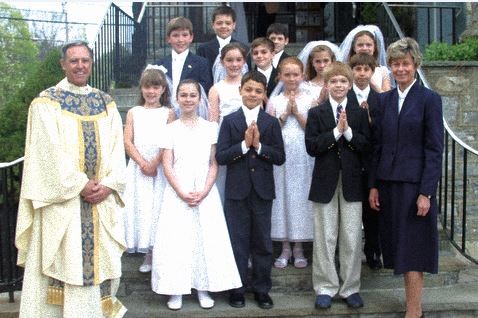 formulate a new vision for the parish, integrating its unique cultural and historical origins with the new realities, and remaining mindful of the significance of being named after the Blessed Mother and the special graces that her patronage bestows. The result was the new mission statement, which was drawn up, approved, and published at the festival Mass on August 10, 2008.
formulate a new vision for the parish, integrating its unique cultural and historical origins with the new realities, and remaining mindful of the significance of being named after the Blessed Mother and the special graces that her patronage bestows. The result was the new mission statement, which was drawn up, approved, and published at the festival Mass on August 10, 2008.
In 2008, the parish celebrated its centennial jubilee. It began in October 2007, with a year of spiritual preparation, and continued throughout 2008. It featured a number of special events including a parish pilgrimage to Italy, the release of a commemorative history book, a senior brunch sponsored by the youth group, a golf outing, and the Jubilee Mass and Gala on May 18, 2008.
Once the festivities of the jubilee celebration had ended, Monsignor Marino set to work to improve the physical plant. He promptly dealt with several crises, including the severe erosion of the steel beam supports in the lower church, caused by years of annual spring flooding. A drainage system to reroute the water was installed around the church to prevent future damage.
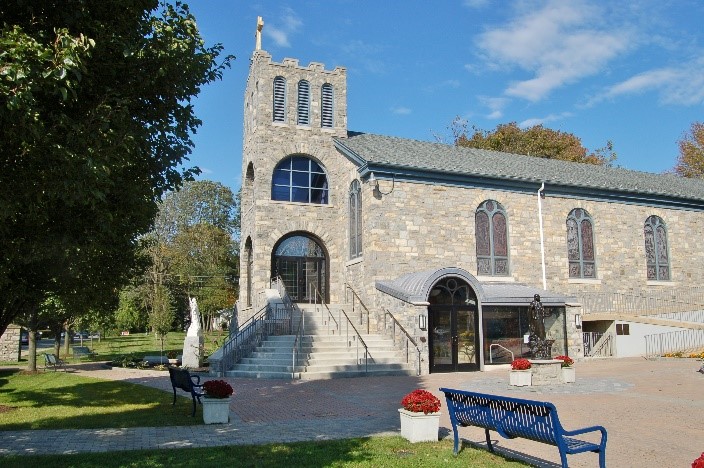 Afterward, Monsignor Marino planned and oversaw a number of long-awaited improvements to the church: the installation of an elevator to accommodate older and handicapped parishioners; the complete renovation of the church basement, creating the Sacred Heart Chapel and a full space for parish offices; implementation of upgrades, such as the firewall between church and rectory, to insure conformity with township codes; the renovation and beautification of the church vestibule, including the relocating of the Assumption window to a new, prominent position; the refurbishing of the outdoor piazza. The entire renovation project was completed by August 2009, in time for the annual Feast of the Assumption. The crowning event later that same year was the Solemn Dedication of the Church by Cardinal Justin Rigali, concelebrated by all current and former living pastors (Monsignor Marino, Bishop Thomas, Monsignor D’Addezio) and priests Father Daniel Hoy and Monsignor James McDonough.
Afterward, Monsignor Marino planned and oversaw a number of long-awaited improvements to the church: the installation of an elevator to accommodate older and handicapped parishioners; the complete renovation of the church basement, creating the Sacred Heart Chapel and a full space for parish offices; implementation of upgrades, such as the firewall between church and rectory, to insure conformity with township codes; the renovation and beautification of the church vestibule, including the relocating of the Assumption window to a new, prominent position; the refurbishing of the outdoor piazza. The entire renovation project was completed by August 2009, in time for the annual Feast of the Assumption. The crowning event later that same year was the Solemn Dedication of the Church by Cardinal Justin Rigali, concelebrated by all current and former living pastors (Monsignor Marino, Bishop Thomas, Monsignor D’Addezio) and priests Father Daniel Hoy and Monsignor James McDonough.
In 2011, in anticipation of the 100th anniversary of the 1917 apparition of Our Lady of Fatima, Monsignor Marino designed and installed a Rosary garden on the lawn on the north side of the church, with statues of the Blessed Mother and the three shepherd children.
At his arrival in 2006, Monsignor Marino had inherited a parish with many challenges—spiritual, material, even existential. When he announced his departure in June 2013 to assume the role of rector of Malvern Retreat House, he left Our Lady of the Assumption on a very firm foundation. During his seven-year pastorate, Our Lady of the Assumption had been blessed with peace and filled with renewed hope.
Father Dennis J. Carbonaro, 2013-2017
F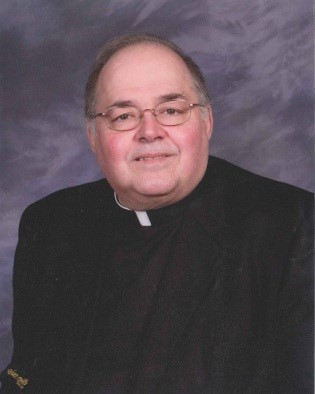 ather Carbonaro began his pastorate on July 1, 2013, following a seven-year pastorate at Our Lady of Consolation in Philadelphia. Previously, he had been many years on the faculty of Saint Charles Borromeo Seminary, working in the formation of seminarians and teaching theology in the College Division. For seven of those years he was director of the Permanent Diaconate Department of the Archdiocese.
ather Carbonaro began his pastorate on July 1, 2013, following a seven-year pastorate at Our Lady of Consolation in Philadelphia. Previously, he had been many years on the faculty of Saint Charles Borromeo Seminary, working in the formation of seminarians and teaching theology in the College Division. For seven of those years he was director of the Permanent Diaconate Department of the Archdiocese.
Father Carbonaro came to Our Lady of the Assumption with a reputation as a gifted homilist and, during his four years here, the congregation was indeed blessed with his rich homilies, delivered with energy, warmth and enthusiasm. His celebration of the Mass was joyful, reverent, and inspiring, and during the sung liturgies, his strong, beautiful voice filled the church. His gifts as a teacher were amply demonstrated during the adult-education sessions he led. His devotion to the children of the school and PREP program was evident in his faithful attendance during their church functions. Most notably, he breathed new life into the annual May Procession by changing it to Monday evening at the close of the PREP year, thereby involving all the PREP children, as well as the entire parish family.
In May 2017, Archbishop Chaput appointed Father Carbonaro as Director of Spiritual Formation in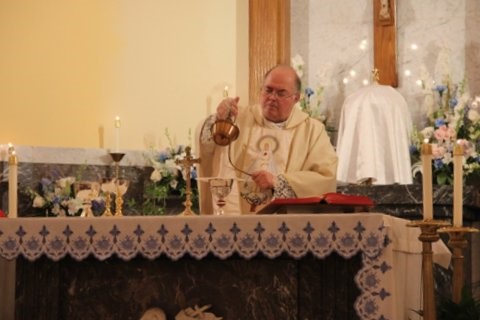 the College Seminary at Saint Charles Borromeo, a post for which he is uniquely gifted. Parishioners were saddened at this news, but they also understood that his unique abilities would reap much fruit at the seminary. On July 12, 2017, parishioners and friends gathered in great numbers to give Father Carbonaro a rousing send-off, with many blessings and good wishes for health and success in his new post at the seminary.
the College Seminary at Saint Charles Borromeo, a post for which he is uniquely gifted. Parishioners were saddened at this news, but they also understood that his unique abilities would reap much fruit at the seminary. On July 12, 2017, parishioners and friends gathered in great numbers to give Father Carbonaro a rousing send-off, with many blessings and good wishes for health and success in his new post at the seminary.
Father Gerald P. Carey, 2017-present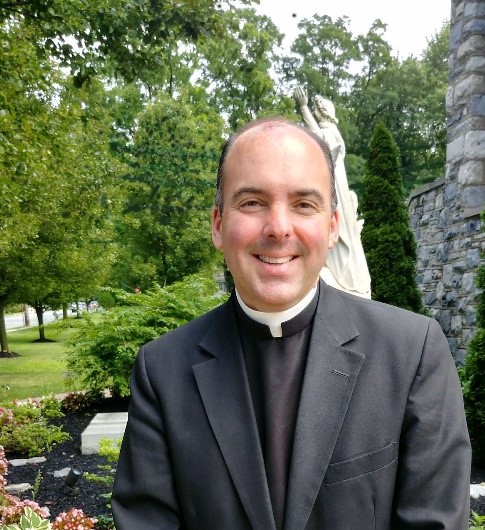
Father Gerald Carey was born in southwest Philadelphia and attended St. Barnabas Elementary School and West Catholic High School for Boys. Upon graduation, he attended Westminster Choir College in Princeton, New Jersey, receiving a bachelor’s degree in Sacred Music. After working in church ministry, he entered St. Charles Borromeo Seminary in 1992 and was ordained a priest by Cardinal Bevilacqua in 1998.
Father Carey’s previous assignments include Corpus Christi Parish in Lansdale; Our Lady of Mt. Carmel in Barceloneta, Puerto Rico; the Cathedral-Basilica of Saints Peter and Paul (Spanish ministry and, later, Director of Office for Worship); St. Paul Parish in South Philadelphia; and most recently, Our Lady of Perpetual Help in Morton, Pennsylvania. He was formally installed as pastor of Our Lady of the Assumption on July 22, 2017, by Bishop John J. McIntyre.
Father Carey has embraced his new role as pastor with joyful enthusiasm, already well started on his stated mission to get to know the parish, its people and its history. He has endeared himself to parishioners, who have responded with wholehearted friendship and cooperation.
Afterword
Our Lady of the Assumption, with a population of about 950 families, has maintained a reputation as a warm and welcoming parish, the legacy of the humble immigrant origins of its early members. Though remaining an Italian “National” (or “Personal”) parish, Our Lady of the Assumption welcomes people of all origins.
Benvenuti!
